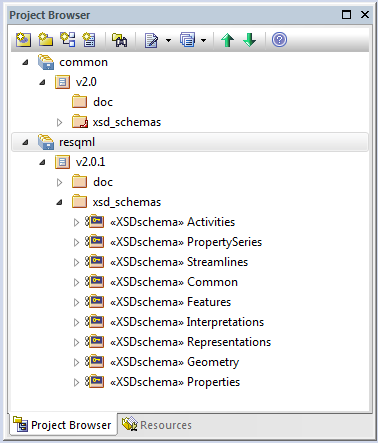3.3 UML Model/Schema Organization
| Topic Version | 1 | Published | 09/11/2015 | |
| For Standard | RESQML v2.0.1 | |||
The RESQML UML model is implemented and organized in an Enterprise Architecture Project (EAP) file, grouped into packages as shown in Figure 3.3-1 and explained below. Each package contains classes that represent the key data objects (see Table 3.4-1 .
The UML model is available as part of the RESQML download. To view the model you need Enterprise Architecture or EA Lite, a free reader available from the company that develops EA, at its website http://www.sparxsystems.com/.

Main packages of the RESQML UML model in EA are listed and described here.
common contains the classes that are used by all Energistics standards, which includes classes to consistently define base data objects and references, coordinate reference systems, and units of measure. For more information, see 4.2 Energistics Common Technical Architecture (common) .
resqml contains these main packages:
- The doc class (folder), which contains packages for:
- ClassDiagrams for the schema packages listed below (with the diagrams labeled appropriately). The class diagrams illustrate the attributes, inheritances, and the other relationships of the packages in the xsd_schemas class (folder).
- InstanceDiagrams with various examples for you to explore.
- The xsd_schema class (folder), which contains these packages:
- Activities, PropertySeries, and Streamlines. New packages for v2.0.1. For more information, see 17 Appendix: New Data Objects for v2.0.1 .
- Common. Shared data objects and related objects that are shared across all packages in a RESQML project. Many objects are extensions of data objects that appear in the shared Energistics-wide common package. For more information, see 4.2 Energistics Common Technical Architecture (common) .
- Features. Organized into two sub-packages—Geologic Features and Technical Features—this package contains all the classes that define the V2.0 business objects, which includes everything that needs to be defined to develop a subsurface model. Features include: horizon, fault, geobody, wellbore, as wells as structural, stratigraphic and earth model organizations, and more.
- Interpretations. Contains all the classes that allow an interpreter to formalize his/her opinion of a feature. A typical example of interpretation is based on the opinion of the geometry of a feature. Other specific interpretation information may include the description of the throw of a fault, the horizon classification in a sequence stratigraphic approach, or the contacts in a structural model.
- Representations. Organized into four sub-packages—Structural, Grids, Seismic and Wells—this package contains all the supported topology, such as triangulation, fault stick, grids (2D grid, IJK grid, PEBI grid, unstructured grid, etc.
- Geometry. Geometry is attached to the indexable elements of a representation. Geometries are not RESQML top-level data objects so cannot be transferred independently.
- Properties. Properties are attached to the indexable elements of a representation. Properties are designed to be transferred independently of a representation and are top-level data objects.